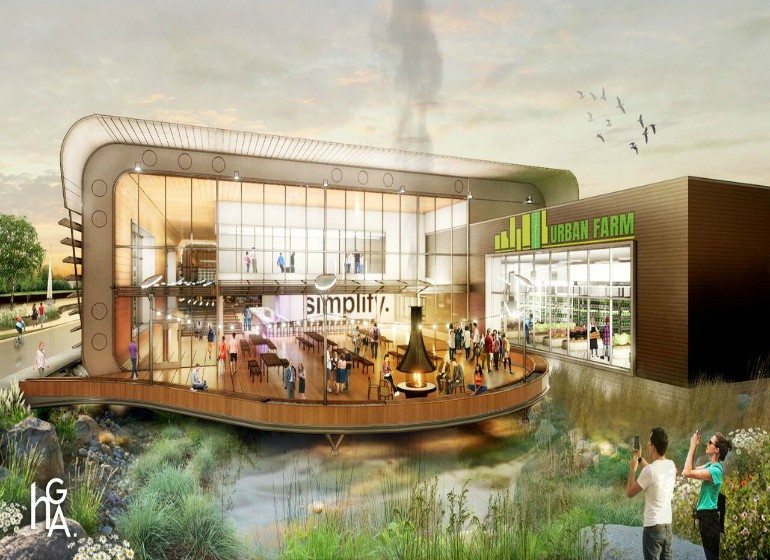Despite 20 years of commercial development and job creation in the Menomonee Valley, there are still dozens of acres of vacant land to be developed, mostly with riverfront access.
The sites remain vacant because they are challenging, but if developed, they could generate up to 800 jobs as well as transform the Menomonee River into a new front door to the valley,” said Corey Zetts, executive director of Menomonee Valley Partners.
Over the last several months, the Menomonee Valley Partners, the city and UWM’s School of Architecture and Urban Planning’s Community Design Solutions worked with six of the city’s architectural firms on a vision for five vacant or underutilized riverfront sites.
“The firms who worked on the charette succeeded in demonstrating the potential of strong design to connect people to jobs, to nature, and to each other,” Zetts said.
The sites include:
1. St. Paul Avenue corridor, 3 acres; Architect: Quorum Architects
In the last two years, six businesses have opened on West St. Paul Avenue between 11th and 25th streets. Quorum Architects proposes expanding the showroom, gallery, and food destination theme, along with sidewalks, lighting, and greening that welcomes pedestrians. Park space, outdoor recreation, and pedestrian connections to the 16th Street Viaduct and Hank Aaron State Trail would provide links. A dog park and skate park are also proposed.
2. City Lights, 1601-2001 W. Mt. Vernon Ave., 12.5 acres; Architect: Zimmerman Architectural Studios
Zimmerman Architectural Studios proposes a riverwalk extension, new street access from 25th Street to Emmber Lane, and three mixed-use commercial buildings along the riverfront. Proposed development includes food production and sale, light industry, and office or other uses. The eastern-most building could connect the 16th Street Viaduct to the riverwalk.
3. Kneeland Properties, 14.8 acres; Architect: HGA
Adjacent to the downtown post office and Milwaukee Intermodal Station, HGA envisions a new street grid to reach destination food and beverage manufacturing and retail, mixed use office, and light manufacturing facing an active riverwalk with boat slips. To connect the site to the city grid, HGA suggests extending Mt. Vernon Avenue under the 6th Street Bridge, traveling along the river and through the existing walkway under the post office, to Plankinton Avenue.
4. Mary’s Cement, 4.7 acres; Architect: Engberg Anderson Architects
Engberg Anderson Architects proposes a gateway and entertainment hub for the riverfront site near the Harley-Davidson Museum. The existing silos would be repurposed as a focal point, possibly carved out and used as part of a hotel. They propose a mix of food manufacturing, retail, office, hotel, and restaurant around a central space connected to a riverwalk extension.
5. We Energies adjacent land, 24.1 acres; Architect: Korb and Associates
The parcel wraps around the We Energies power plant and runs adjacent to the Menomonee Canal to the south. New construction on the site can capitalize on adjacent food grade steam for facilities, manufacturing, and food and beverage production and retail. The size of the site and proximity to entertainment destinations, with frontage on both Canal Street and the Menomonee Canal, make it attractive for a manufacturer with a retail/tourism component
6. 199 N. 25th St., 2.5 acres; Architect: Uihlein/Wilson – Ramlow/Stein Architects
With a prominent location on 25th and Canal Streets, this site sits between the Hank Aaron State Trail and the Menomonee River. The existing building has a steel structure that could be renovated for a single tenant or multiple smaller tenants, possibly a combination of food manufacturing and visitor’s center, retail outlet, or themed restaurant. A proposed addition provides opportunity for a highly visible vertical landmark and entrance point to the valley.
Rocky Marcoux, commissioner of the Milwaukee Department of City Development, said the design concepts suggest the best days of the valley are still ahead of it.
From here, the plans will be circulated to the brokerage community. We Energies has been marketing its site and Marcoux said the owner of the city lights property, is willing to move forward with a project.
Marcoux is interested in looking at the Kneeland proposal and talking to Matt Garrison, managing principal of Chicago-based R2, which purchased the downtown Post Office in October 2016, about extending Mount Vernon Avenue to the Third Ward.
“It would be ideal if we could get the roads put in,” Marcoux said. “If we could get the roads and could get rid of the mountain of dirt, then I think we could really get people excited.”
To do so, a tax incremental financing district would be created to fund the infrastructure. The TIF would be repaid by the development, provided commercial properties are developed.
If not, the tax levy would pay for the infrastructure.
Marcoux said he would like to have a proposal to the Milwaukee Common Council this fall.




